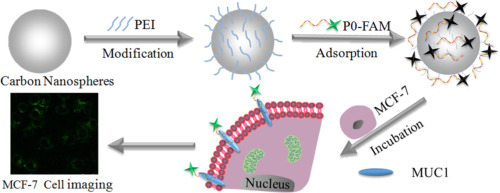Talanta ( IF 5.6 ) Pub Date : 2018-03-15 , DOI: 10.1016/j.talanta.2018.03.045 Dandan Yang , Mei Liu , Jing Xu , Chao Yang , Xiaoxiao Wang , Yongbing Lou , Nongyue He , Zhifei Wang

|
In this work, carbon nanosphere (CNS)-based fluorescence “turn off/on” aptasensor was developed for targeted detection of breast cancer cell MCF-7 by conjugation with FAM (a dye)-labeled mucin1 (MUC1) aptamer P0 (P0-FAM), which can recognize MUC1 protein overexpressed on the surface of MCF-7. Different from other carbon based fluorescence quenching materials, CNSs prepared by the carbonization of glucose not only have the high fluorescence quenching efficiency (98.8%), but also possess negligible cytotoxicity (in the concentration range of 0–1 mg/mL, which is 10 times higher than that of traditional carbon nanotubes or graphene oxide (0–100 µg/mL)). As for the detection of the mimic of the tumor antigen MUC1, the resulting fluorescence intensity increases nearly linearly in the range of 0–6 μM with the limit of detection (LOD) of 25 nM.
中文翻译:

基于碳纳米球的荧光适体传感器可靶向检测乳腺癌细胞MCF-7
在这项工作中,开发了基于碳纳米球(CNS)的荧光“关闭/开启”适体传感器,通过与FAM(染料)标记的粘蛋白1(MUC1)适体P0(P0- FAM),可以识别在MCF-7表面过表达的MUC1蛋白。与其他碳基荧光猝灭材料不同,通过葡萄糖碳化制得的CNS不仅具有较高的荧光猝灭效率(98.8%),而且细胞毒性也可以忽略不计(浓度范围为0-1 mg / mL,即10)。是传统碳纳米管或氧化石墨烯(0–100 µg / mL)的两倍。至于检测肿瘤抗原MUC1的模拟物,所得荧光强度在0–6μM范围内几乎呈线性增加,而检测限(LOD)为25 nM。









































 京公网安备 11010802027423号
京公网安备 11010802027423号